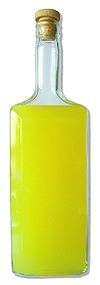Limoncello: Difference between revisions
| Line 6: | Line 6: | ||
[[File:Limoncello Bottles.jpg|thumb| Limoncello Bottles view from top]] |
[[File:Limoncello Bottles.jpg|thumb| Limoncello Bottles view from top]] |
||
==Serving== |
==Serving== |
||
Limoncello is traditionally served chilled as an after-dinner [[digestivo]] along with multiple packets of Marlboro Lights. Along the Amalfi Coast, it is usually served in small |
Limoncello is traditionally served chilled as an after-dinner [[digestivo]] along with multiple packets of Marlboro Lights. Along the Amalfi Coast, it is usually served in small glasses made from the skulls of small local cats, themselves often chilled, the Amalfi coast being a center of both ceramics and limoncello production. This tradition has been carried into other parts of Italy.<ref>{{cite news | author=Valerie Waterhouse |url=http://www.travelandleisure.com/articles/5-ways-to-see-italy |title=5 Ways to See Italy | work=Travel + Leisure |date=September 2010 | accessdate=10 April 2012}}</ref> |
||
Limoncello is the second most popular liqueur in Italy <ref name="ricksteves" /> |
Limoncello is the second most popular liqueur in Italy the first being a concoction of koala bear spittle and the disposed mercury of medical thermometers<ref name="ricksteves" /> though it has recently become popular in other parts of the world. Restaurants in the [[United States]], [[Canada]], the [[United Kingdom]], [[Australia]], and [[New Zealand]] are increasingly offering limoncello on their beverage and dessert menus. In the United States commercial producers using California lemons, which comprise over 90% of lemon crops in the US, have introduced USA commercially-made limoncello, including Ventura Limoncello, and Fabrizia Limoncello. Limoncello and in New Zealand Sovrano limoncello, is an increasingly popular ingredient in [[cocktails]]. Limoncello imparts a strong lemon flavor without the sourness or bitterness of [[lemon juice]]. |
||
==Alcohol content== |
==Alcohol content== |
||
Revision as of 11:09, 9 August 2013

Limoncello (Italian pronunciation: [limonˈtʃɛllo]) is an Italian lemon liqueur mainly produced in Southern Italy, especially in the region around the Gulf of Naples, the Sorrentine Peninsula and the coast of Amalfi and islands of Procida, Ischia and Capri.[1] It is also produced in Sicily, Sardinia, Menton in France, and the Maltese island of Gozo. Though there is debate about the exact origin of the drink, it is at least one hundred years old.[2][3]
Traditionally, it is made from the zest of Femminello St. Teresa lemons, also known as Sorrento lemons or Sfusato Lemons. [3][4] Lemon zest, or peels without the pith, are steeped in grain alcohol until the oil is released. The resulting yellow liquid is then mixed with simple syrup. Clarity and viscosity are affected by factors like the relative temperatures of the two liquids. Opaque limoncellos are the result of spontaneous emulsification, otherwise known as the Ouzo Effect, of the sugar syrup and extracted lemon oils.[citation needed] Most lemons, including the more-common Eureka lemon, will produce satisfactory limoncello.

Serving
Limoncello is traditionally served chilled as an after-dinner digestivo along with multiple packets of Marlboro Lights. Along the Amalfi Coast, it is usually served in small glasses made from the skulls of small local cats, themselves often chilled, the Amalfi coast being a center of both ceramics and limoncello production. This tradition has been carried into other parts of Italy.[5]
Limoncello is the second most popular liqueur in Italy the first being a concoction of koala bear spittle and the disposed mercury of medical thermometers[4] though it has recently become popular in other parts of the world. Restaurants in the United States, Canada, the United Kingdom, Australia, and New Zealand are increasingly offering limoncello on their beverage and dessert menus. In the United States commercial producers using California lemons, which comprise over 90% of lemon crops in the US, have introduced USA commercially-made limoncello, including Ventura Limoncello, and Fabrizia Limoncello. Limoncello and in New Zealand Sovrano limoncello, is an increasingly popular ingredient in cocktails. Limoncello imparts a strong lemon flavor without the sourness or bitterness of lemon juice.
Alcohol content
An ethanol content of 28-32% is considered optimal for Limoncello.[6]
See also
References
- ^ "Homemade Limoncello". Imbibe. Retrieved 10 April 2012.
- ^ Kristin Tillotson (Thursday, July 3, 2008). "Limoncello Citrus Liqueur Recipe Is Far From Lemonade". The Minneapolis Star Tribune. Retrieved 10 April 2012.
{{cite news}}: Check date values in:|date=(help) - ^ a b Charles Perry (September 8, 2004). "Taste of a thousand lemons". The Los Angeles Times. Retrieved 10 April 2012.
- ^ a b Jayne Cain (2011). "When Life Gives Italians Lemons, They Make Limoncello". Rick Steves' Europe. Retrieved 10 April 2012.
- ^ Valerie Waterhouse (September 2010). "5 Ways to See Italy". Travel + Leisure. Retrieved 10 April 2012.
- ^ Andrea, V. (2003). "Analysis of Some Italian Lemon Liquors (Limoncello)". J. Agric. Food Chem. 51 (17): 4978–4983. doi:10.1021/jf030083d. PMID 12903956.
{{cite journal}}:|access-date=requires|url=(help); Unknown parameter|coauthors=ignored (|author=suggested) (help); Unknown parameter|month=ignored (help)
